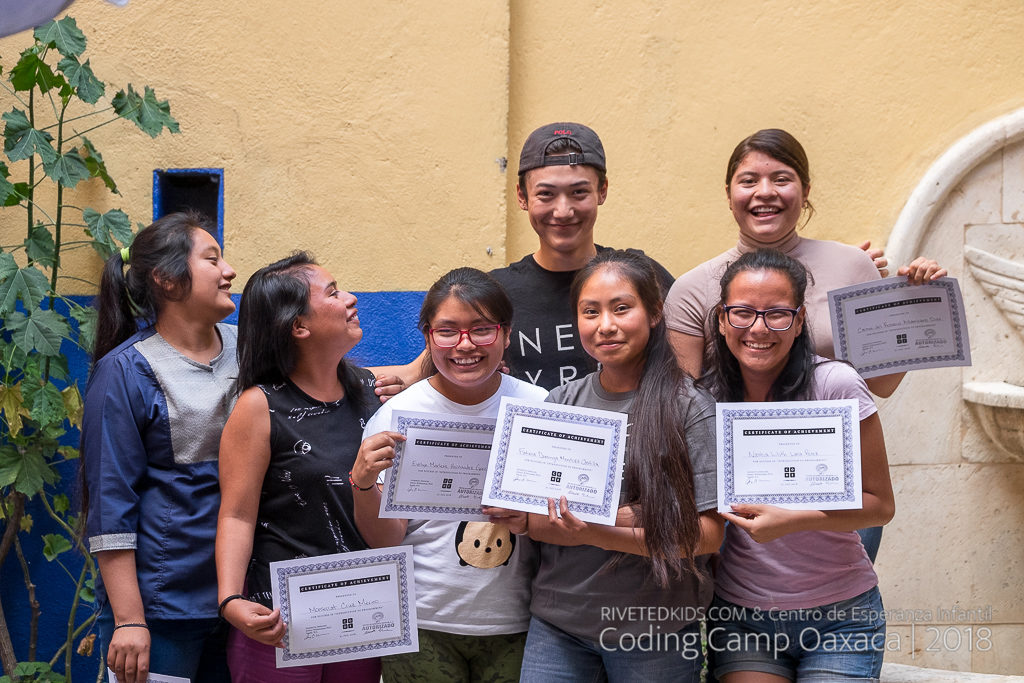
Elliot and I entered through the Center’s big wooden door. It was noonish with a hot sun so we welcomed the shaded entrance. There was a serene and quiet contrast to the bustle and car noises of historic downtown Oaxaca. We were greeted by the portero who was signing in visitors at the door and he recognized us now. To our left in the cafetería we caught glimpses of students waiting patiently for Doña Juanita to serve them lunch; we could smell mole coming out of her kitchen from around the corner. We were ready for another afternoon of “Coding Camp” with six amazing students from Oaxaca!
Elliot was my camper for the week: A 17-year old high school student from Seattle who signed up for an adventure and a chance to build on his Spanish skills. And he was getting a lot of both! He was also getting six fun, inquisitive, new friends – Oaxacan students from El Centro de Esperanza Infantil (CEI) who wanted to learn how to code.
As we passed through the inner courtyard that lit up from the hot afternoon sun, we said hello to Directora Erendira, the Center’s director who always seemed to have a ton going on in her office. We gave high fives to some smaller kids (“¡Choca esos cinco!”) who were playing by the metal patio tables and then we bounded up the stairs to set up for the afternoon activities. We had established an interactive routine where each day we’d first have lunch with the students, play some team building games, and then jump into learning how to code.
How it all started
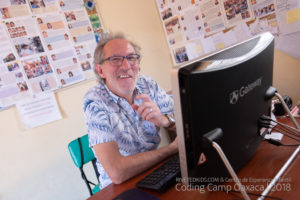
The idea for the Coding Camp started over a year ago when we were traveling through Oaxaca on a Riveted Kids family trip. We stopped by CEI because we heard positive things about their work and we were curious to learn more. We got a great tour from Directora Erendira who told us about all the educational support (e.g., money for books, school supplies, lunches, and tutoring) that the Center gives to over 600 local students. We also met Peppo, a jovial Italian ex-pat who lives in Oaxaca and runs many CEI programs and manages their modern computer lab.
Peppo and I stayed in touch and over the winter we discussed whether the CEI students would be interested in a course on computer programming. I had taught both programming and Spanish language, so I was interested in combining the two strengths. So, with Peppo’s encouragement and coordination, we set up: He’d recruit students from the Center and I’d come down with any willing campers with a Riveted Kids camp.
Elliot was my sole assistant, and this was his first trip abroad. He joined with some solid high school Spanish skills but hadn’t done any coding, which worked out great. In this way he was learning alongside the Oaxacan students. He was fun to be around, positive with all activities, and friendly with our new Oaxacan friends.
Was it really about learning to code?
It quickly became clear during the week, that the real magic was not about learning to code. I think the more important impact for both Elliot and the Oaxacan students was reflecting in our objectives which we talked about at length with the students :
1) Have fun
2) Gain confidence
3) Create connections
#1 Fun for everyone
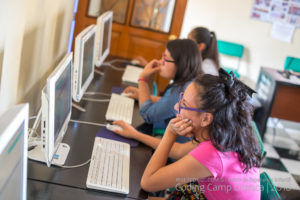
I really wanted this “class” to feel fun and inviting. I wanted both Elliot and the Oaxacan students to look forward to each day. To this end, Elliot and I made sure to be there each day for lunch. We made small talk, told jokes, and laughed over strange language expressions. For example, we practiced responding to “What’s up?” with dramatic chin-nods and I declared Doña Juanita’s super spicy salsa with my own phrasing “mata-gringos” (gringo killer) which made us all laugh.
Of course, I had to use my camp counselor skills. We played team building games and icebreakers. For example, the “ha-ha-hee-hee” game where we couldn’t go back into the computer lab after a break until we were able to form a line with hands on each other’s backs, saying “ha-ha-hee-hee” without anyone smiling or laughing. (It’s hard. Try it!)
Another example of fun was awarding candy prizes for correct answers to lesson quizzes. Elliot was able to practice his Spanish by purchasing the candy each day down the street at a corner store. To keep activities inclusive, we practiced some of the lessons in pairs. And importantly, we just took a relaxed attitude with no pressure on the students to have to get through the whole coding course.
#2 Confidence boosts all around
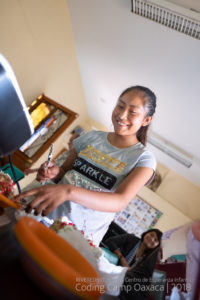
As a dad of a 13-year-old girl, I really wanted each of the students (all six happened to be girls) to feel a sense of achievement from their week’s work. Walking through 20+ lessons of Code.org requires lots focus and problem solving. Building coding skills for girls is even more significant when you consider that women are an underrepresented group across STEM fields world-wide. In Mexico, women make up fewer than 10% of computer engineers. So in addition to encouragement, I made sure to show them videos each day made by women in engineering (mostly Latina women) talking about their work, showcasing their journeys, and encouraging other young women on the possibilities.
With Elliot, I worked on building his confidence by spending time with him before our Mexico trip going over the curriculum and helping him get started. We did a lot of our planning in Spanish to help him exercise his conversational muscles. We also brainstormed how to structure the classes and how he could best support the learning. Each day he exercised leadership by coming up with some of the activities and then leading some of the online quiz activities. (Elliot, you rocked it!)
#3 Connections? Yes! Both between them and with us.
The more I get to know the world, the more I believe that connections between people are what really matter. Connections make for a more compassionate, kind, and sustainable world. For Elliot and the girls, my hope was that they got to know each other better, create friendships, and add to their support networks. In addition, Elliot and I felt like ambassadors from Seattle and the USA. I know that we had a blast and we recognized, despite cultural differences, how similar we all were to each other – goofy, inquisitive, and we all love group games.
So what’s next? (More camps like this, please!)
Next summer we are planning a camp in coordination with CEI with our new One For All program. But instead of just doing afternoon activities at CEI like we did this summer, we’ll do a week-long camp with both US and Oaxacan students. I can’t imagine a better way to bring young people together, practice language, share cultures, and make new friends. For the Oaxaca students, the camp will be free as with all the Center’s programming.
If you are Interested in sending a child or grandchild along with us to have a camp in experience in Oaxaca alongside cool and fun students from Oaxaca, please let us know. You can stay in the know and get notified first for camp registration here.
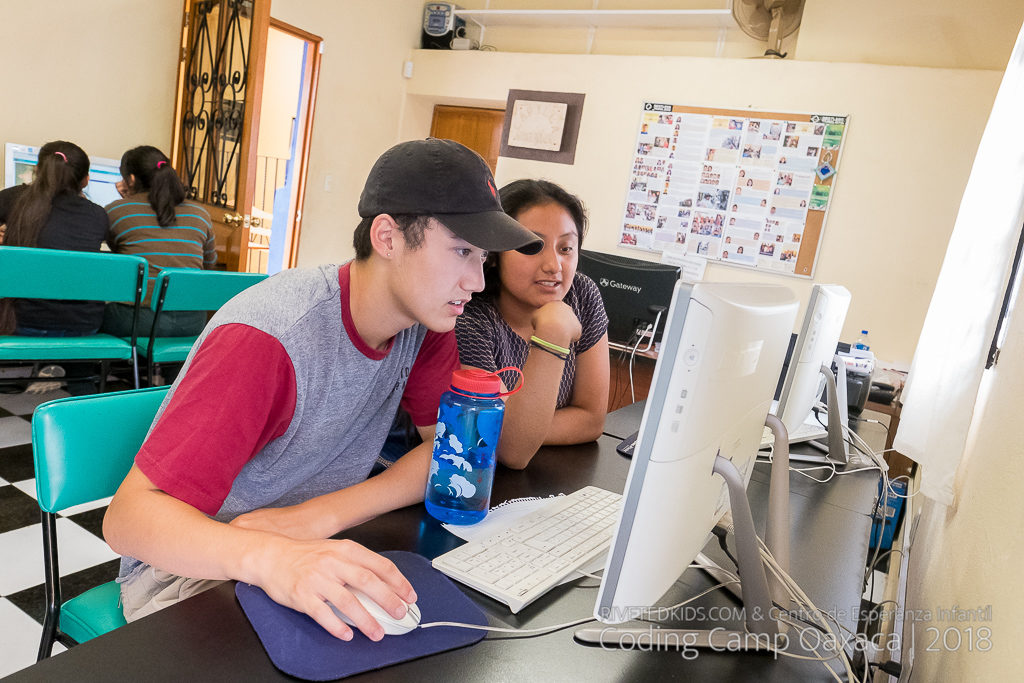
More photos?
You can see more photos from just our time at the Center or photos that include our adventures around Oaxaca.
More about the Centro de Esperanza Infantil
The best way to think of the Centro de Experanza Infantil (CEI or “Oaxaca Streetchildren Grassroots” in English) is to liken it to a Boys and Girls Club. However, at the CEI the kids all come from situations of strong financial need and are at risk to not staying or doing well in school. CEI has a sponsor model where many sponsors are from the United States. For $250 US dollars/year, a sponsorship pays for a single student’s schooling costs (e.g., text books, uniform, school and athletic shoes), gives the student access to free meals at the Center, provides free tutoring to ensure passing grades, and offers free classes/workshops like the coding workshop described in this post.
Now that I have been at the center, met the caring staff, and gotten to know some kids – I’m a BIG fan of the work they are doing and its impact. Please consider supporting CEI. You can read more about it on their English language website or Facebook page. And here is an AmazonSmile link to support the organization.
Leave a Reply